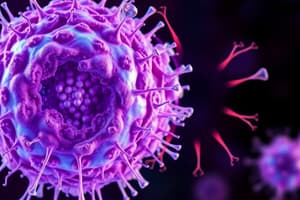Podcast
Questions and Answers
What type of organism is classified as Prokaryotic?
What type of organism is classified as Prokaryotic?
- Animals
- Bacteria (correct)
- Plants
- Fungi
Eukaryotic cells are unicellular.
Eukaryotic cells are unicellular.
False (B)
What is the main difference in organelles between Prokaryotic and Eukaryotic cells?
What is the main difference in organelles between Prokaryotic and Eukaryotic cells?
Prokaryotic cells have no membrane-bound organelles, while Eukaryotic cells do.
Eukaryotic cells contain a _____ that houses their DNA.
Eukaryotic cells contain a _____ that houses their DNA.
Match the following characteristics with Prokaryotic or Eukaryotic cells:
Match the following characteristics with Prokaryotic or Eukaryotic cells:
Which of the following is NOT found in Prokaryotic cells?
Which of the following is NOT found in Prokaryotic cells?
Flashcards are hidden until you start studying
Study Notes
Lesson Objective
- Distinguish features and functions of prokaryotic and eukaryotic cells.
Differences Between Prokaryotic and Eukaryotic Cells
-
Prokaryotic Cells:
- Found in organisms classified as prokaryotes, including bacteria and archaea.
- Typically unicellular, consisting of a single cell.
- Lack membrane-bound organelles such as mitochondria, lysosomes, and Golgi apparatus.
- DNA is located in the nucleoid region, consisting of a single strand in bacterial cells.
- May possess a capsule for extra protection and structures like pili for attachment and flagella for movement.
-
Eukaryotic Cells:
- Characteristic of complex organisms, including animals, plants, fungi, and protists (like algae and amoeba).
- Can be multicellular (comprising multiple cells) or unicellular (e.g., amoeba).
- Contain membrane-bound organelles, including nuclei, endoplasmic reticulum, Golgi apparatus, and more.
- DNA is contained within a defined nucleus.
- Exhibit various structures for movement, such as flagella (ex: sperm) and cilia (for attachment).
Studying That Suits You
Use AI to generate personalized quizzes and flashcards to suit your learning preferences.




